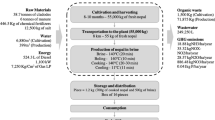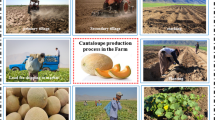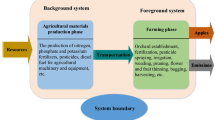Abstract
Purpose
Evaluate environmental load of the agriculture industry by taking Chongming Island of Shanghai as a case study. Propose feasible approaches to reduce the environmental impact of agriculture industry based on the research findings.
Methods
The research boundary of our study covers from raw material extraction to agriculture product (cradle to product). Two stages are identified based on life cycle thinking: agricultural material production and planting process. In the agriculture material stage, we evaluated the consumption of agricultural machinery and equipment for diesel, gasoline and electricity; then, the embodied environmental impact of these energy sources are calculated based on life cycle assessment (LCA). For the planting stage, we calculated the environmental impact caused by agriculture sowing, fertilizing, and spraying of pesticides also according to the LCA method.
Results and discussion
The environmental impacts of Chongming Island in 2015 are found as ecosystem damage (2.44E+11 species year), human health (2.86E+10 DALY), and resources consumption (1.15E+09 $). The primary environmental impacts in the agricultural material production stage are revealed as marine ecological toxicity (1.01E+06), freshwater eutrophication (5.26E+05), and human toxicity (4.04E+05), of which 90% of the impacts are caused by the production of nitrogen fertilizer, phosphorus fertilizer, and potassium fertilizer. The main environmental impacts in the agricultural planting stage are freshwater ecotoxicity (1.27E+06), freshwater eutrophication (7.70E+05), and terrestrial ecotoxicity (7.70E+05), which are mainly caused by pesticide residues and loss of nitrogen fertilizer, phosphorus fertilizer, and potassium fertilizer.
Conclusions
The results of the environmental impact analysis of the Chongming agricultural production of 2008–2015 showed that there was a significant decline trend in 2011 and 2012, mainly due to the significant reduction in the use of nitrogen fertilizer. The main measures for the practitioner to reduce the potential ecological damage to agricultural production are controlling the N, P, and K fertilizer application and pesticide spray volume. In addition, the ecological environment can be improved by exploring techniques and measures for efficient utilization of agricultural resources such as optimizing the amount of fertilizer and application rate.







Similar content being viewed by others
References
Bartl K, Verones F, Hellweg S (2012) Life cycle assessment based evaluation of regional impacts from agricultural production at the peruvian coast. Environ Sci Technol 46(18):9872–9880
Brentrup F, Kusters J, Kuhlmann H et al (2004) Environmental impact assessment of agricultural production systems using the life cycle assessment method I. Theoretical concept of a LCA method tailored to agriculture production. Eur J Agron 20(3):247–264
Chong T, Li M, Ai-qing W et al (2007) Calculation and analysis of agricultural ecological footprint in Bashang area of Hebei Province. J Chin Soc Eco-Agric 15(3):151–154 (in Chinese)
Chongming Statistical Yearbook (2016) Shanghai Chongming County Bureau of Statistics. https://pan.baidu.com/s/1WIMlomplyc1KIsRawv2yBA (in Chinese)
Cowell SJ, Clift R (1997) Impact assessment for LCAs involving agricultural production. Int J Life Cycle Assess 2(2):99–103
Goedkoop M, Heijungs R, Huijbregts M, De Schryver A, Struijs J, Van Zelm R (2009) ReCiPe 2008. A life cycle impact assessment method which comprises harmonised category indicators at the midpoint and the endpoint level, 1st edn. Report I: characterisation, pp 1–126
Heinonen J, Säynäjoki A, Junnonen JM, Pöyry A, Junnila S (2016) Pre-use phase lca of a multi-story residential building: can greenhouse gas emissions be used as a more general environmental performance indicator? Build Environ 95:116–125
Huang B, Mauerhofer V (2016) Low carbon technology assessment and planning case analysis of building sector in Chongming, Shanghai. Renew Energ 86:324–331
Huang B, Zhao F, Fishman T (2018) Building material use and associated environmental impacts in China 2000–2015. Environ Sci Technol 52(23):14006–14014
Huijbregts MAJ, Steinmann ZJN, Elshout PMF, Stam G, Verones F, Vieira M, Zijp M, Hollander A, van Zelm R (2017) Recipe2016: a harmonised life cycle impact assessment method at midpoint and endpoint level. Int J Life Cycle Assess 22(2):138–147
ISO 14040 (2006) International standard. In: Environmental management – life cycle assessment – principles and framework. International Organization for Normalization, Geneva
Jungbluth N, Büsser S, Frischknecht R, Flury K, Stucki M (2012) Feasibility of environmental product information based on life cycle thinking and recommendations for Switzerland. J Clean Prod 28:187–197
Khoshnevisan B, Shafiei M, Rajaeifar MA, Tabatabaei M (2016) Biogas and bioethanol production from pinewood pre-treated with steam explosion and n-methylmorpholine-n-oxide (nmmo): a comparative life cycle assessment approach. Energy 114:935–950
Klöpffer W, Grahl B (2016) Life cycle assessment (LCA): a guide to best practice. Int J Life Cycle Assess 21:1063–1066
Laurent A, Olsen SI, Hauschild MZ (2011) Normalization in EDIP97 and EDIP2003: updated European inventory for 2004 and guidance towards a consistent use in practice. Int J Life Cycle Assess 16:401–409
Lewis KA, Bardon KS (1998) A computer-based environmental management system for agriculture. Environ Model Softw 13(2):123–137
Ma Z (2008) Effects of heavy metals on farmland soil and agricultural product safety and its management evaluation system. China Agricultural University, Beijing, pp 54–72 (in Chinese)
Mishima S, Tanoiguchi S, Komada M (2005) Adaptation of life cycle assessment (LCA) to agricultural production on a regional scale in Japan. Trans Ecol Environ. https://doi.org/10.2495/ECO050661
Owsianiak M, Laurent A, Bjørn A, Hauschild MZ (2014) IMPACT 2002+, ReCiPe 2008 and ILCD’s recommended practice for characterization modelling in life cycle impact assessment: a case study-based comparison. Int J Life Cycle Assess 19(5):1007–1021
Paolotti L, Boggia A, Castellini C, Rocchi L, Rosati A (2016) Combining livestock and tree crops to improve sustainability in agriculture: a case study using the life cycle assessment (LCA) approach. J Clean Prod 131:351–363
Peng X, Wu X, Wu F et al (2015) Life cycle assessment of winter wheat summer maize rotation system in Guanzhong region of Shaanxi. J Agro Environ Sci 4:809–816 (in Chinese)
Poritosh R, Daisuke N, Takahiro O et al (2009) A review of life cycle assessment (LCA) on some food products. J Food Eng 90(1):1–10
Rigby D, Woodhouse P, Young T, Burton M (2001) Constructing a farm level indicator of sustainable agricultural practice. Ecol Econ 39:463–478
The First National Pollution Source Census Leading Group Office (2009) The first national pollution source census: agricultural pollution source fertilizer loss coefficient manual. the State Council, Beijing (in Chinese)
Tolle DA (1997) Regional scaling and normalization in LCIA. Development and application of methods. Int J Life Cycle Assess 2:197–208
Wang X, Zhao X, Wang Y et al (2017) Carbon footprint analysis of rice production in China. Resour Sci 39(4):713–722 (in Chinese)
Yang Y, Lin W (2015) Environmental impact assessment of different maize planting patterns—based on LCA. Agric Mech Res 12:1–6 (in Chinese)
Funding
The research work is supported by grant from the National Natural Science Foundation of China (No. 71403170). Zhibo Lu is financially supported by the Shanghai Science and Technology Committee (No. 15DZ1208103).
Author information
Authors and Affiliations
Corresponding authors
Additional information
Responsible editor: Zuoren Nie
Publisher’s note
Springer Nature remains neutral with regard to jurisdictional claims in published maps and institutional affiliations.
Electronic supplementary material
ESM 1
(DOCX 41 kb)
Rights and permissions
About this article
Cite this article
Li, S., Huang, B., Zhao, F. et al. Environmental impact assessment of agricultural production in Chongming ecological island. Int J Life Cycle Assess 24, 1937–1947 (2019). https://doi.org/10.1007/s11367-019-01614-w
Received:
Accepted:
Published:
Issue Date:
DOI: https://doi.org/10.1007/s11367-019-01614-w




